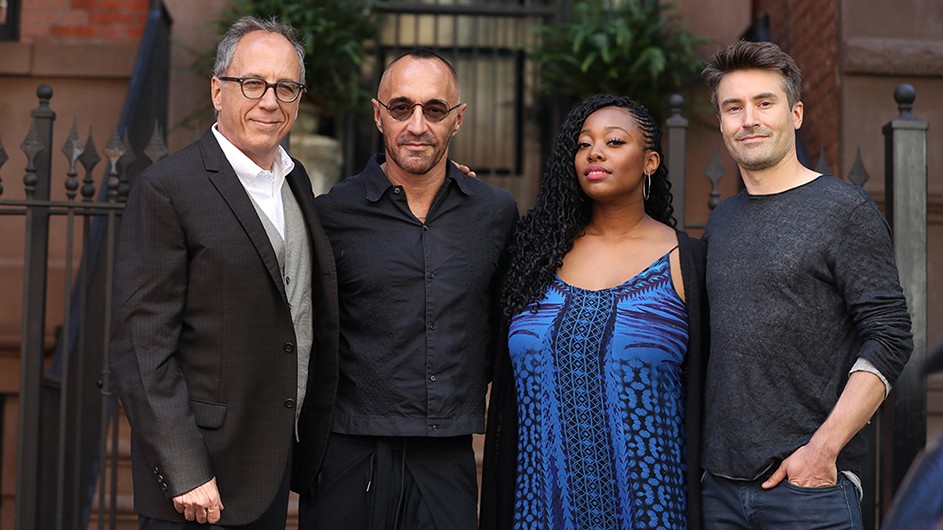‘The Parsonage’ Tells the Tales in Music of a Single New York City Building
Journalism School Professor David Hajdu examines key moments of urban history in a song cycle.

Columbia Journalism School Professor David Hajdu’s latest project, The Parsonage, revolves around a building located in the East Village—64 East 7th Street—which played an important role in a series of dramatic New York City historical moments that occurred throughout the 20th century and into the first decades of the 21st.
Hajdu identified eight key events involving the building, and decided to create a work of historical nonfiction in musical form, an eight-song cycle for which he wrote all the lyrics and collaborated with a different composer for each song: Darcy James Argue, Theo Bleckmann, Regina Carter, Ted Hearne, Kurt Nurock, Renee Rosnes, Sarah Kirkland Snider, and Dan Tepfer. On April 7, the CD, The Parsonage: True Tales of Love and Anarchy at 64 East 7th Street, will be released by Sunnyside Records, and there will be a premiere concert of the song cycle at the Museum of the City of New York at 7 pm on April 27.
Hadju discusses The Parsonage with Columbia News, along with the book he’s writing now, and the course he’s currently teaching.
How did this project come about?
When I was a student at NYU, I used to come to Morningside Heights to hear jazz at the West End Bar on Broadway near West 114th Street. Today, the place is a board-game bar. I was thinking about the dynamic between material constancy and cultural change, and how one building can have multiple lives as it is adapted to suit the purposes of multiple time periods.
I started researching the history of buildings in New York, going methodically through the city records for historical district designations. I made a list of buildings with fascinating histories of change, and one jumped out—64 East 7th Street. The five-story brick townhouse, built in 1840 as the parsonage for St. Mark’s Church, was at the heart of an improbable series of important moments in New York's cultural and social history, from the 1904 Slocum disaster, when a sidewheel passenger steamboat caught fire and sank in the East River, to the Wall Street bombing of 1920, and the rise of Beat poetry and performance art in lower Manhattan.
I thought that the story of this building would make a great subject for a song cycle, with the music for each song written by a different composer. I wrote a libretto for eight songs, and brought it to eight contemporary composers I admired, and the project started coming together.
What do you think is the single most interesting historical tale out of 64 East 7th Street included in The Parsonage?
The extraordinary thing about this building is that each of the eight stories told in the eight songs is equally dramatic. My personal favorite might be the building's stint as The Paradox, the first macrobiotic restaurant in New York. One of the waitresses was a young woman named Yoko Ono, who decided to use the tiny space between the dining area and the kitchen to do what she called "happenings," such as tying herself inside a big black bag and doing things—or doing nothing—inside. Before long, people came to know what she was doing as performance art.
How did you segue from journalism professor to librettist?
I've been serious about writing or co-writing music for some time. The jazz pianist and composer Renee Rosnes and I have an ongoing songwriting partnership, with a full album of our work, Ice on the Hudson, released a few years ago. As a journalist, cultural historian, and educator, my field is the arts with a special concentration on music. I find that having an active art practice benefits my writing, scholarship, and teaching. I don't feel like I'm toggling back and forth between art making and art writing or education. It's all connected for me.
The Parsonage is historical, a nonfiction song cycle. Prior to this, I wrote a novel, Adrianne Geffel, about the avant-garde music scene in New York during the 1980s, told in the form of an oral history—essentially, a fictional work of nonfiction. These projects are inquiries into the relationship between scholarship and creativity.
What are you working on now?
I'm writing a book about A.I., machine-made art, and computational creativity, with a historical and critical orientation, a somewhat unusual way of looking at the subject.
What are you teaching this semester?
A graduate seminar in arts criticism. Right before spring break, I had each of the students present a work of original art to the class for another student to review, so they could experience the creative process firsthand and see what it feels like to be criticized. I'm going through the same thing right now with The Parsonage, and I expect to learn from the experience.